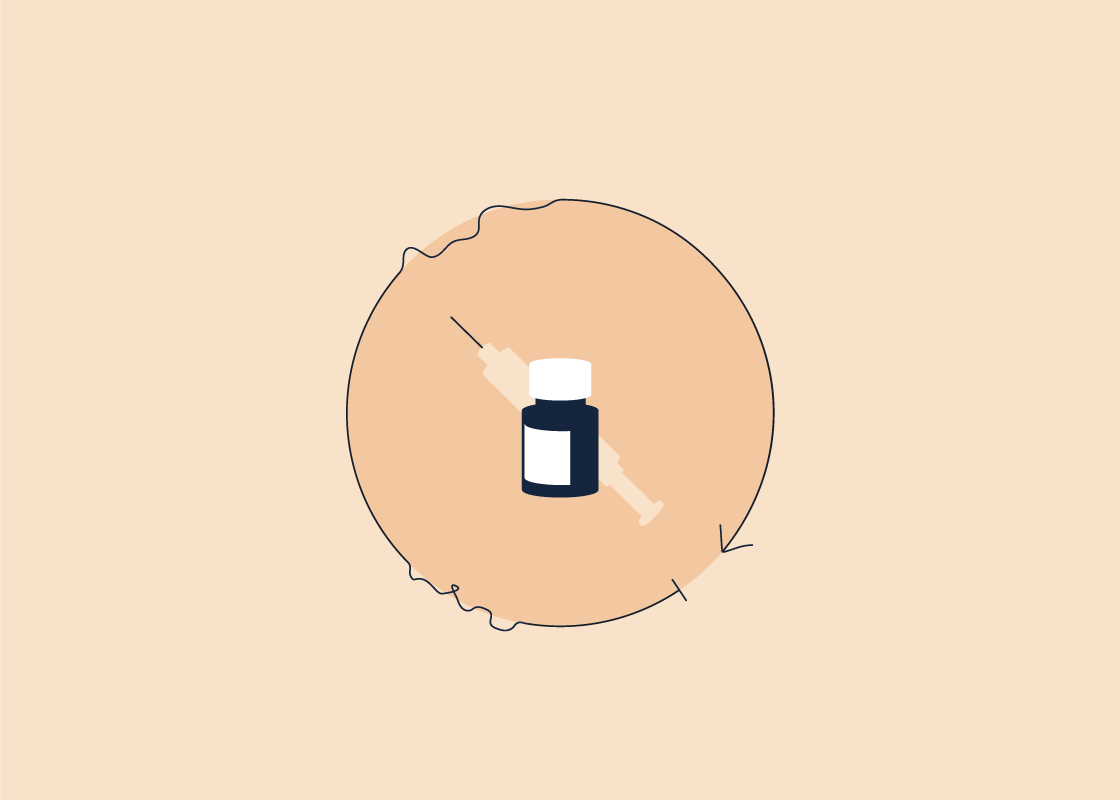If you’re looking to conceive, tracking your ovulation period is one practical way to boost your chances of getting pregnant.
Sure, having sex more often will be helpful. But being able to pinpoint the optimal time to have sex will hike up your odds of pregnancy by a large margin. Detecting the women’s fertile period may also be helpful for couples who do not wish to get pregnant [1].
Because your body is unique, you will not share the same cycle as everyone else.
But fret not—we’ve got your back. We’ll walk you through the different signs and symptoms of ovulation you can look out for, as well as how you can track your cycle and pinpoint your ovulation date.
What Is Ovulation?
You may be curious about what this big ‘O’ actually is. Ovulation is part of your menstrual cycle, and it refers to the process by which a mature egg is released from your ovary.
The first day of your menstrual cycle falls on the day your period begins. This day also marks the start of the follicular phase, which will last until the day of ovulation. During the follicular phase, your body will release follicle-stimulating hormone (FSH) that fosters the maturation of your egg, preparing it for release.
As the grand day of ovulation nears, your body will then release a surge of luteinizing hormone (LH), which signals for the release of your mature egg. On ovulation day, this egg is released from the ovary before it makes its trip down the fallopian tube.
Ovulation usually lands in the middle of your cycle. The egg can be fertilised by a viable sperm as it travels down the fallopian tube, leading to pregnancy.
After ovulation occurs, the luteal phase commences. At this stage, your uterus thickens in anticipation of a possible pregnancy. If no fertilised egg is received during this time, your menses begins, and the cycle repeats.
And that’s a quick summary of the series of events that take place throughout your menstrual cycle.
Why Should I Track My Ovulation?
So, what’s the massive deal about ovulation?
Well, science has already spoken, and very clearly, too. If you’re eager to conceive, here’s a crucial piece of information you should know: The six most fertile days of your cycle fall on the five days before ovulation occurs and on the day of ovulation itself [2].
This six-day window of opportunity is the only time in the cycle when you can fall pregnant when having sexual intercourse. Research has also found that having sex on the two days before the day of ovulation has resulted in the highest conception rate [2].
Studies have also shown that only 30% of women have a fertile window that falls entirely within the days identified by clinical guidelines, which is between days 10 and 17 of their cycle [3].
The other 70% of women do not have a standard 28-day cycle, meaning their fertile period will fall between different dates. As a result, many women cannot fall back on cookie-cutter guidelines to accurately determine their own fertile period.
From all this information, you may now realise that your ovulation date may differ from someone else’s. If you want to conceive, tracking your ovulation date allows you to pinpoint the prime time to have fun in the sheets, which is during your most fertile period.
You can track your ovulation date by looking out for symptoms that occur before, after, and on ovulation day itself.
6 Signs and Symptoms of Ovulation
Here are some signs and symptoms of ovulation to keep an eye out for.
Changes in basal body temperature
Shortly after ovulation occurs, your body releases progesterone, a sex hormone. This drives a spike in body temperature. Hence, keeping track of your basal body temperature (BBT) from month to month can give you an idea of when ovulation usually takes place during your cycle [4].
Charting your BBT daily will usually show you an increase in body temperature of around 0.5 to 1 degrees F shortly after ovulation has occurred. This slight rise in body temperature will usually continue until the first day of your menses before returning to normal [4].
This method of tracking isn't the most practical, though. You'd have to take your temperature at the same time each day, preferably upon waking up. And factors such as jet lag or alcohol consumption could affect the accuracy of your readings.
Thin and clear cervical fluid
Your cervix produces a slippery fluid called cervical mucus, which facilitates the movement of the sperm towards a matured egg. The rise in the female hormone estrogen right before ovulation increases the secretion of this nutrition-rich fluid [5]. Hence, this greater volume of discharge is a symptom of ovulation.
Other than that, you may also observe a difference in the texture and consistency of the mucus. It becomes thinner and stretchier during your fertile window, often described as having an egg white texture.
The change in texture and volume of cervical mucus around ovulation helps the sperm reach the grand prize and makes activities in the bedroom more pleasurable.
Ovulation pain
Have you ever experienced some sort of pain in one side of your lower abdomen? Does this pain usually appear around the middle of your cycle? If so, you may be experiencing ovulation pain.
It manifests as a sharp pain, cramp, or twinge that is often temporary. Not every woman experiences this, and if they do, it doesn’t always recur each month. This pain is thought to be caused by the contraction of the fallopian tube as the egg is released [6]. In a sense, it announces the nearing arrival of ovulation
For some women, the pain presents as a minor ache, but for others, it is agonising enough to disrupt their daily routine. If the pain becomes very severe, though, it’s always safest to get it checked out by your doctor.
Breast tenderness
Some women may experience breast tenderness or sore nipples around the time of ovulation. However, this is not an accurate indicator of ovulation because you may also experience these symptoms at other points of your cycle, such as during your menses.
The breast pain or tenderness results from a change in hormones. Nonetheless, if it becomes unbearable, you should get it checked by your doctor to rule out more severe causes such as breast cancer.
Changes in sex drive
Do your sexual urges get a massive boost during certain times of the month? Well, scientific studies have reported an increase in sexual activity in women three days before and during the LH surge, which occurs just 24-36 hours before ovulation. This is usually accompanied by heightened sexual desire [7].
Hence, you may notice a massive leap in libido nearing your ovulation date. Since this timeframe is your fertile period, that’s just a sign that your body’s rooting for you to get pregnant. This explains the natural changes in hormone levels that take place, giving your libido an extra kick.
Spotting or discharge
Ovulation spotting or bleeding is rare, but some women may experience light bleeding that presents nearing their time of ovulation. Spotting is more likely to occur in women who produce greater amounts of progesterone and LH. However, whether you experience spotting does not determine your fertility [8, 9].
On a side note, a handful of women may also experience nausea during ovulation. However, nausea that happens after ovulation and nearing your period is more likely due to pregnancy.
How Long Do Ovulation Symptoms Last?
This really depends on which symptom you’re referring to. For instance, an increase in BBT will usually persist until the first day of your menses, and this is usually the same case with nipple pain or breast discomfort. Nonetheless, the timeframe of symptoms differs from woman to woman.
How Can I Track My Ovulation?
There are various ways you can track your cycle and ovulation date. Some at-home methods include:
- Charting your daily body basal temperature
- Using ovulation predictor urine kits
- Utilising saliva ferning predictor kits
- Observing changes in your cervical mucus
- Charting dates on a calendar to track your cycle manually
- Making use of smartphone apps or ovulation-tracker devices
Methods such as recording your daily temperature can be a hassle to keep up with, and calendar manual tracking is highly unreliable if your cycle tends to be irregular.
One excellent option that overcomes these limitations is the science-backed tool called the inne minilab. You’ll no longer have to keep a watchful eye out for symptoms of ovulation before jumping your partner or tediously calculate and record dates on your calendar. Instead, this device allows you to keep track of your cycle with lab-grade accuracy through simple saliva tests.
All your results will be viewed and analysed in a companion app on your smartphone, allowing you to learn more about your cycle. And by directly measuring your hormone levels, this smart tool depicts your unique hormone curve and predicts when your ovulation is likely to occur.
Essentially, inne makes ovulation tracking a no-brainer. And with this information readily available at your fingertips, all you need to focus on is baby-making. ;)
References
[1] Unseld M, Rötzer E, Weigl R, Masel EK, Manhart MD. Use of Natural Family Planning (NFP) and Its Effect on Couple Relationships and Sexual Satisfaction: A Multi-Country Survey of NFP Users from US and Europe. Front Public Health. 2017;5:42. Published 2017 Mar 13. doi:10.3389/fpubh.2017.00042
[2] Dunson DB, Baird DD, Wilcox AJ, Weinberg CR. Day-specific probabilities of clinical pregnancy based on two studies with imperfect measures of ovulation. Hum Reprod. 1999;14(7):1835-1839. doi:10.1093/humrep/14.7.1835
[3] Wilcox AJ, Dunson D, Baird DD. The timing of the "fertile window" in the menstrual cycle: day specific estimates from a prospective study. BMJ. 2000;321(7271):1259-1262. doi:10.1136/bmj.321.7271.1259
[4] Steward K, Raja A. Physiology, Ovulation And Basal Body Temperature. StatPearls. Treasure Island (FL). Published 2021 July 22.
[5] Najmabadi S, Schliep KC, Simonsen SE, Porucznik CA, Egger MJ, Stanford JB. Cervical mucus patterns and the fertile window in women without known subfertility: a pooled analysis of three cohorts. Hum Reprod. 2021;36(7):1784-1795. doi:10.1093/humrep/deab049
[6] Brott NR, Le JK. Mittelschmerz. In: StatPearls. Treasure Island (FL): StatPearls Publishing; May 9, 2021.
[7] Bullivant SB, Sellergren SA, Stern K, et al. Women's sexual experience during the menstrual cycle: identification of the sexual phase by noninvasive measurement of luteinizing hormone. J Sex Res. 2004;41(1):82-93. doi:10.1080/00224490409552216
[8] Dasharathy SS, Mumford SL, Pollack AZ, et al. Menstrual bleeding patterns among regularly menstruating women. Am J Epidemiol. 2012;175(6):536-545. doi:10.1093/aje/kwr356
[9] Crawford NM, Pritchard DA, Herring AH, Steiner AZ. Prospective evaluation of the impact of intermenstrual bleeding on natural fertility. Fertil Steril. 2016;105(5):1294-1300. doi:10.1016/j.fertnstert.2016.01.015




